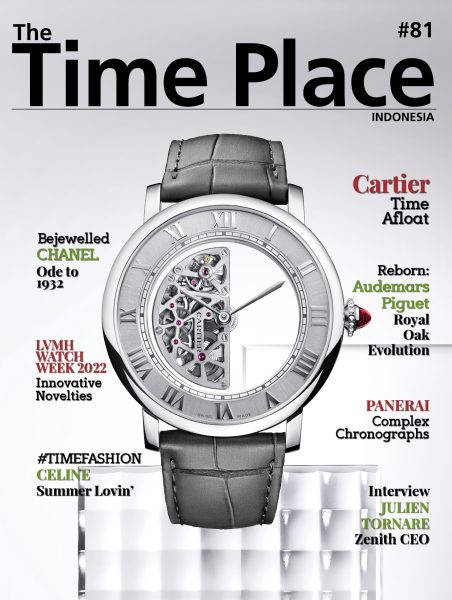Magnified at 50: Audemars Piguet Royal Oak’s 50th Anniversary
By The Time Place Magazine
Audemars Piguet celebrates the Royal Oak’s 50th anniversary with a round-up of new models.
When it comes to iconic collections, one of the most popular (and undeniably most enduring) is the Royal Oak from Audemars Piguet. Distinguished by its tonneau-shaped case, octagonal bezel and eight visible hexagonal screws, the Royal Oak has been in a state of constant evolution since 1976. With more than 500 versions released since its inception, this singular watch has categorically shaped the course of Audemars Piguet’s watchmaking journey.

For 50 years, the Royal Oak has remained a pillar in the manufacture’s repertoire of offerings. To pay tribute to the collection’s rich and enduring history, Audemars Piguet is releasing a wide array of new Royal Oak models in a variety of sizes, case materials and dial colours, with some iterations even further enhanced by the addition of sparkling diamonds.
Through the Years
Created during a time when quartz watches were slowly causing an upheaval in the mechanical watchmaking industry, the Royal Oak served as a symbol of defiance against the new technology from Japan. The year was 1972 when Audemars Piguet entrusted Gérald Genta to design a novel timepiece catering especially to a new generation of clients. The talented watchmaker came up with a high-end sports model with an ultra-contemporary aesthetic – the Royal Oak – which was fashioned in stainless steel, then an unconventional material in watchmaking. More difficult to handle than gold, the use of steel required new tools and techniques, and because of its innate hardness, was chosen specifically to protect the thinnest selfwinding movement of the era, developed by Audemars Piguet in 1967.

Sporty and versatile, the Royal Oak could be worn anywhere, making it perfectly suitable to the more active lifestyle emerging in the 1970s. With a 39 mm diameter, the timepiece was nicknamed Jumbo and was renowned for its unique characteristics: a large octagonal bezel, a tonneau-shaped case, hexagonal screws, an integrated steel bracelet with links descending in size, and an innovative engine-turned ‘Tapisserie’ dial. Furthermore, the watch featured refined traditional finishing techniques, including alternating hand-polished and satin-brushed surfaces that have since become a trademark of the collection. Named after the “royal” oak tree that saved the life of King Charles II of England in 1651 in the Battle of Worcester, the Royal Oak evokes strength, legacy and innovation, and rightfully describes the appearance of the watch: a body of steel with a heart of gold.
Set apart by its substantial size and avant-garde design, the Royal Oak broke the mould during a time when men’s watches were normally small, round, and made of precious metals. Many people thought that Audemars Piguet would not withstand the backlash from such an offering, however, much to the public’s surprise, the demand for the brand’s latest novelty picked up as more and more people became familiar with the attributes of the watch. Due to this inspiring development, Audemars Piguet’s Head of Product Design, Jacqueline Dimier, decided to create a version for women in 1976.

Through the years, the Royal Oak has been in continuous evolution. It has seen numerous iterations, sizes, case materials, styles and have included various complications, including chronographs and perpetual calendars, as well as Grandes Complications. Furthermore, the Royal Oak has also paved the way for a number of new models and design innovations: the muscular and robust Royal Oak Offshore which debuted in 1993, followed by the Royal Oak Concept in 2002. These watches have since led to the birth of two full-fledged collections, further affirming Audemars Piguet’s place in Haute Horlogerie.
To 50 Years
This year, Audemars Piguet celebrates the history and continued relevance of the Royal Oak with a dazzling array of new watches. Composed of 37 mm selfwinding hour, minute, second and date versions as well as 38 and 41 mm selfwinding chronographs, the attractive novelties enrich the already impressive collection.
Though new in terms of their attributes, the watches still continue to uphold the iconic design codes of the original Royal Oak, albeit with slight variations to their case, dial and bracelet designs. This is a testament to the brand’s improvement approach, to how Audemars Piguet has consistently pushed the limits of design and mastery across generations. To get to the heart of the matter, let us first focus on the watch case and bracelet.

The latest offerings within the Royal Oak collection are available in either stainless steel or 18-carat pink gold and feature enlarged bevels on the top and the bottom of the case, allowing for the heightened play of light between the satin-finished and polished surfaces, while providing a leaner aesthetic. The case back is now also slightly more integrated into the case middle for the wearer’s comfort. In support of the fine new case design, the integrated bracelet’s first four links are now trapezoid in shape and no longer parallel. This decrease in thickness, including thinner links throughout the bracelet, enhances the bracelet’s taper and makes it lighter, making it not only more pleasing to the eye, but also more ergonomic to wear.
Apart from this, the dial aesthetics of the latest offerings have been harmonised. Part of the Royal Oak’s recognisable features, the luminescent facetted hour markers and their proportions have been standardised, in accordance to their individual diameters. The logo, which features prominent on the watch face, has been reworked. Replacing the applied AP monogram and “AUDEMARS PIGUET” at 12 o’clock is a gold Audemars Piguet signature in a unique topography. Lastly, the minute track previously printed on the flat external zone, is now incorporated on the Tapisserie of all Royal Oak selfwinding hour, minute, second and date models.
Colour also enhances the Royal Oak’s dials. From pink gold, black, khaki green, silver-toned and “Bleu Nuit, Nuage 50” for the 41 mm selfwinding chronographs; light blue, grey, silver-toned and “Bleu Nuit, Nuage 50” for the 38 mm selfwinding chronographs; and khaki green, silver-toned, grey, light blue, and “Bleu Nuit, Nuage 50” for the 37 mm selfwinding hour, minute, second and date versions. Notably, this profusion of colour includes “Bleu Nuit, Nuage 50”, originally developed by Geneva-based dial maker Stern Frères. The rich blue hue is obtained by immersing each dial in a specifically timed galvanic bath, while the “nuage” or cloud effect resulting from a drop of black is accomplished thanks to a protective liquid varnish.

Of course it won’t be a Royal Oak without a guilloché Tapisserie dial. This pattern, achieved through a complex manufacturing process, is composed of hundreds of small truncated pyramids with square bases. Carved out on the dial’s thin metal plate by an old guilloché copying machine that reproduces the motif of a matrix, the Tapisserie motif is created only with extreme dexterity and precision. The product of a rare know-how, the Tapisserie motif adds beautiful depth to the dial and allows it to wonderfully reflect light.
From the front to the back, the Royal Oak 50th anniversary models are fitted with the dedicated oscillating weight in 22-carat gold that features the “50-years” logo and the engraved Audemars Piguet signature. This unique feature is crafted in the same material as the watch case, with an alternation of satin-finishing and polished chamfers. All the anniversary models will showcase this new oscillating weight, with the exception of the 38 mm chronographs.
A model that truly showcases Audemars Piguet’s prowess in haute horlogerie, the Royal Oak is a timepiece that has endured and evolved over the years. Still bearing its signature design codes, the watch continues to uphold the brand’s heritage and paves the way for a bright and hopeful future in watchmaking.
#ReadAtHome the latest issue of The Time Place Magazine

